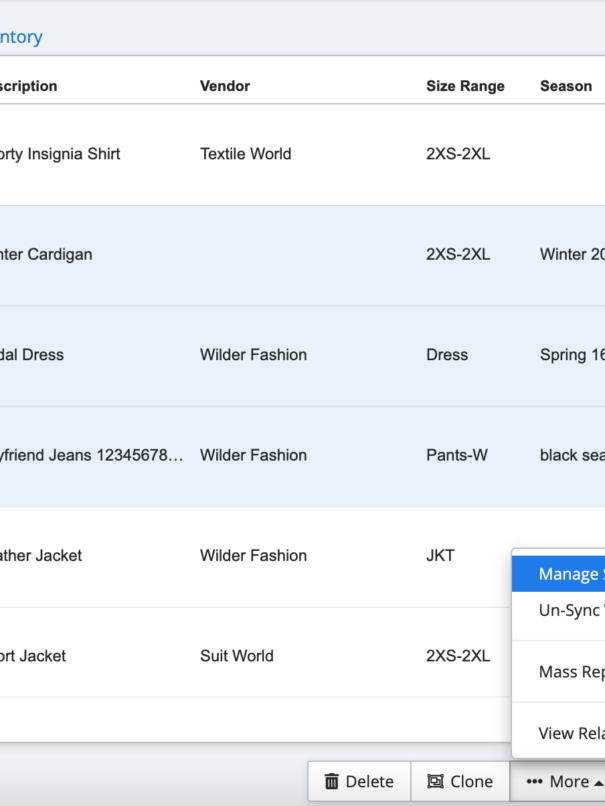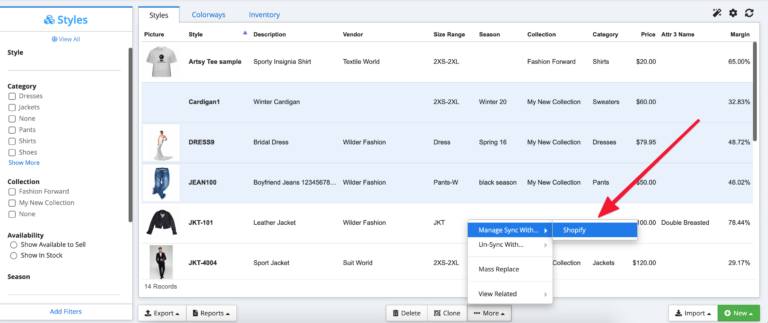Overstock inventory occurs when businesses hold more stock than they can sell. This ties up cash, uses storage space, and can devalue a brand. In this article, you’ll learn the causes, effects, and prevention strategies for overstock inventory, especially for apparel brands.
What is Overstock Inventory?
Overstock inventory refers to having more inventory than needed, leading to surplus stock that sits unsold in storage. For apparel brands, this can be particularly problematic due to the fast-changing nature of fashion trends and seasonal demand cycles. Unlike other industries, the shelf life of fashion items is fleeting, making it crucial to balance how much inventory is ordered and sold.
When an apparel business holds more inventory than it can sell, it leads to excess stock. This not only ties up working capital but also takes up valuable storage space and can damage the brand’s reputation if customers see outdated stock. Proper inventory management thus becomes essential to navigate these challenges effectively.
The impact of overstock inventory on apparel brands is multifaceted. It affects profit margins, storage costs, and can even lead to brand dilution if not managed properly. Therefore, understanding the causes and implementing effective inventory management strategies is vital for maintaining a healthy balance of inventory levels.
Root Causes of Overstock Inventory for Apparel Brands
One of the primary culprits behind overstock inventory in apparel brands is rapidly changing fashion trends. The desire to stay ahead of trends often leads to overproduction, resulting in surplus stock that quickly becomes obsolete. This is compounded by inaccurate demand forecasting, where businesses misjudge how much stock is needed, leading to either over or understock situations.
Overproduction to meet Minimum Order Quantities (MOQs) is another significant factor. Apparel brands often produce more inventory than necessary to meet supplier requirements, which can result in excess inventory. Seasonal overordering also plays a role, with businesses stocking up on seasonal items only to find that consumer demand doesn’t match their predictions.
Poor inventory visibility exacerbates these issues. Without proper inventory management tools, businesses struggle to keep track of inventory levels, leading to overstocking inventory. Additionally, shifts in consumer behavior can leave businesses with excessive stock that no longer meets customer preferences.
Effective inventory management requires a comprehensive approach that addresses these root causes. Understanding and mitigating these factors helps apparel brands align their inventory levels with actual customer demand, reducing the risk of overstocked items and improving overall efficiency.
Consequences of Overstock Inventory for Apparel Brands
The financial strain caused by overstock inventory is perhaps the most immediate and tangible consequence. Excess stock ties up working capital that could be better used in other areas of the business, leading to increased operational costs and reduced cash flow. The storage costs associated with maintaining surplus stock can also eat into profit margins, making it crucial for businesses to manage their inventory levels effectively.
Beyond the financial implications, overstock inventory can lead to brand dilution. When businesses are forced to offer significant discounts to clear excess stock, it can devalue the brand in the eyes of consumers. This not only affects current sales but can also impact future demand, as customers come to expect frequent markdowns.
Product waste and obsolescence are other significant consequences. Fashion items that remain unsold for too long may become outdated, leading to waste and potential environmental harm. The environmental impact of overstock inventory extends beyond just waste, as the resources used to produce these items also go to waste.
Given these far-reaching consequences, it becomes clear that apparel businesses need to adopt effective inventory management strategies. This includes preventing overstock situations through better demand forecasting, inventory tracking, and leveraging technology to gain real-time insights into inventory levels.
Preventing Overstock Inventory: Strategies for Apparel Brands
Adopting real-time accurate demand forecasting can significantly reduce the risk of overstock inventory. Leveraging advanced analytics and historical sales data enables apparel brands to forecast demand more accurately and adjust their inventory levels accordingly. Investing in smart inventory management software also plays a crucial role in this process, offering real-time inventory data and insights that help businesses make informed decisions.
Flexible and on-demand manufacturing is another strategy that can help prevent overstocking. Producing inventory in smaller batches based on current demand helps businesses avoid the pitfalls of overproduction. Sustainability-driven inventory planning, which emphasizes responsible sourcing and production practices, can also mitigate the risks associated with excess stock in the supply chain.
Optimizing promotions without damaging the brand is essential. Rather than resorting to steep discounts, businesses can use targeted promotions to move inventory without devaluing their products. Enhancing omnichannel integration ensures that inventory is visible and available across all sales channels, reducing the likelihood of overstock in any single location.
Monitoring consumer trends and feedback is vital for maintaining effective inventory management. Staying attuned to shifts in consumer preferences enables apparel brands to adjust their inventory strategies in real time, ensuring they have enough stock to meet demand without overstocking, ultimately enhancing customer satisfaction.
How ApparelMagic Helps
ApparelMagic is a powerful inventory management system designed specifically for apparel businesses. It provides tools that help prevent overstock inventory, improve operations, and ensure better decision-making. Here’s how ApparelMagic can make a real difference for your business:
Accurate Demand Forecasting
ApparelMagic uses advanced analytics and machine learning to provide precise demand forecasts. By analyzing past sales data, seasonal trends, and current market conditions, the system helps businesses predict how much inventory is actually needed. This prevents overordering and ensures you’re not stuck with unsold products taking up storage space.
Real-Time Inventory Tracking
ApparelMagic keeps track of your inventory in real-time across all warehouses, stores, and sales channels. Whether it’s a retail location, an e-commerce platform, or a supplier, you’ll have a clear view of stock levels at all times. This visibility helps you avoid both overstocking and understocking while optimizing your inventory flow.
Multi-Channel Integration
Apparel businesses often sell across multiple platforms, including online stores, retail shops, and wholesale channels. ApparelMagic integrates with major platforms like Shopify, Amazon, and others, syncing inventory seamlessly. This eliminates duplicate stock issues, reduces errors, and ensures your inventory is always accurate across all sales points.
Smart Production Management
Overproduction is a leading cause of excess inventory. ApparelMagic helps businesses manage production efficiently with features like material tracking, Bill of Materials (BOM) creation, and production order management. By enabling smaller batch production and on-demand manufacturing, the system helps businesses stay flexible and avoid overproducing unnecessary stock.
Comprehensive Reporting and Insights
ApparelMagic provides clear, detailed reports that highlight critical metrics like sales performance, slow-moving inventory, and turnover rates. These insights make it easier to identify which products are performing well and which aren’t. With this data, businesses can adjust their purchasing, plan smarter promotions, and clear excess stock without resorting to deep discounts.
Warehouse and Order Management
The system improves warehouse efficiency by enabling seamless inventory transfers between locations, automating order fulfillment, and alerting you to low stock levels. This means your stock is always organized, easy to locate, and ready to meet demand. Efficient warehouse management reduces costs and prevents unnecessary storage issues.
Scalable and Flexible Solution
ApparelMagic is built to grow with your business. Whether you’re a small brand or a large apparel company, the system adapts to your needs, offering scalability as your operations expand. This flexibility ensures long-term inventory control without disruptions.
Improved Seasonal Planning
Seasonal demand and fashion trends can make inventory planning tricky for apparel businesses. ApparelMagic helps you analyze historical and current trends to plan inventory for upcoming seasons. This reduces the chances of overordering for products that may not sell as expected, allowing you to stay aligned with market demand.
Wrap Up
Overstock inventory presents significant challenges for apparel brands, from financial strain to environmental impact. Understanding the root causes, such as rapidly changing fashion trends and inaccurate demand forecasting, is the first step in addressing this issue. Effective inventory management strategies, including real-time demand forecasting and smart inventory management systems, are crucial for preventing overstock situations.
The consequences of overstock inventory, including brand dilution and product waste, highlight the importance of proactive management. By adopting strategies like flexible manufacturing, sustainability-driven planning, and leveraging technology, businesses can mitigate the risks associated with excess stock.







